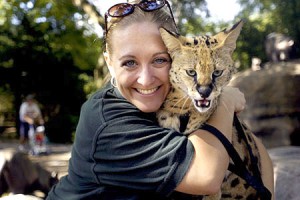I found this picture in an advertisement website, where the advertisement is promoting “A day of being a zookeeper”. Therefore, this picture is a perfect way to represent what a great day you can have by being a zookeeper! At first glance, this picture looks as if both the zookeeper (the woman in the photo) and the serval (type of cat) are content with their situation during the moment of the picture. The zookeeper is wearing a smile on her face that runs from ear to ear, the serval and the zookeeper are both seemingly sharing a hug, and it even looks as if the serval is enjoying the hug; her ears are perked up as if it were a dog when it hears the word “walk”, and it even looks like she has a smile running through her face. This image makes the viewer assume that every person in this image (including the serval) is enjoying the moment at the zoo. But as you look deeper into the picture, you can see that there is a more critical perspective of this image.
The first part of the image that can be dissected is the background zoo. Tall grasslands, woods, savannahs, and other places associated to these types of habitats are mostly where servals are habituated. Concrete and boulders, as shown in the background, are not. Berger would say that the only reason we believe that this is a happy picture of a serval and a zookeeper is because of our nostalgia of zoo’s and how we see these types of animals as magical because of this great nostalgia of something we are not used to seeing. By remembering the way these zoo animals were in our nostalgia, we are creating in our minds the image of a serval, and by creating this image we are devaluing the actual animal for how it is because this animal will never live up the expectations our minds create.
Alice Walker would look at the way the animal actually feels, rather than where it is located. At closer look, the eyes of the serval tell its real emotions. The serval looks fiercely focused into space, which in many animal languages, is a sign of basically saying “back off”. Secondly, the “smile” can be interpreted as the serval’s hiss, also a sign of “back off”. The serval seems to be actually trying to push its self away from the zookeeper, instead of into the zookeeper.
By searching zookeeper into the internet, I knew I would be able to find an image that seems so inviting and loving towards animals, but could also be shown to have a more critical side to how we as humans are related to animals.
Works Cited:
Berger, John. Why Look At Animals?. New York: Vintage International, 1977. Print.
Walker, Alice. “Am I Blue?”. Other Nations. Baylor University Press. 182-187. Print.
http://www.zavvi.com/gift-experience-days/zookeeper-experience-zookeeper-for-a-day/10051858.html
http://www.servals.org/wild.htm

Recent Comments